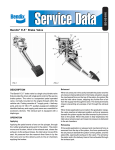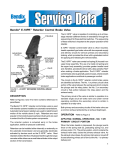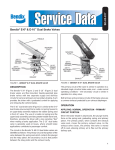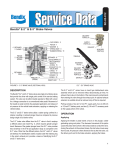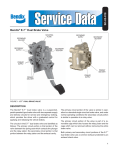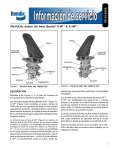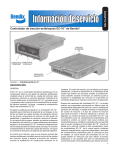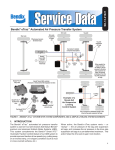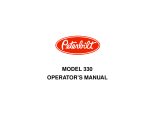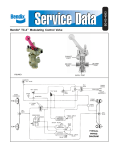Download BENDIX BW1622 User's Manual
Transcript
SD-03-826 ® Bendix® E-12™ & E-15™ Dual Brake Valve TREADLE MOUNTING PLATE UPPER BODY ASSEMBLY PRIMARY SUPPLY ( SUP-1 ) 11 PRIMARY DELIVERY ( DEL-1 ) 21 PRIMARY SUPPLY ( SUP-2 ) 12 SECONDARY DELIVERY ( DEL-2 ) 22 LOWER BODY ASSEMBLY PRIMARY DELIVERY ( DEL-1 ) 21 SECONDARY DELIVERY ( DEL-2 ) 22 EXHAUST FIGURE 1 - E-12™ AND E-15™ DUAL BRAKE VALVES DESCRIPTION E-12™ DUAL BRAKE VALVE ↑ TREADLE TRAVEL E-15™ DUAL BRAKE VALVE PRIMARY DELIVERY (PSI) The E-12™ and E-15™ brake valves are similar in design with the exception of the rubber spring (9) and spring retainer (7) located in the upper body. The rubber spring which is used in the E-12™ brake valve alters the performance of the valve such that the primary circuit delivers full reservoir pressure to the spring brakes with less treadle travel than that of the E-15™ brake valve. See Figure 2 for delivery pressure versus treadle travel diagram. The greater treadle travel of the E-15™ brake valve yields a more gradual delivery of air to the spring brakes resulting in a less sensitive “feel” to the driver when a brake application is made. This characteristic makes the E-15™ brake valve more adaptable to transit vehicle applications where smooth brake applications contribute to passenger comfort. The E-12™ and E-15™ valves are designed such that the treadle does not sit in an upright position until the air system is built up to full reservoir pressure. The supply pressure moves the primary piston upward transmitting a mechanical force to the spring retainer and plunger of the treadle assembly, causing the treadle to move upright. PRIMARY DELIVERY (PSI) The E-12™ and E-15™ dual brake valves are floor mounted, treadle operated type brake valves with two separate supply and delivery circuits for service and secondary braking. The separation of circuits provides the driver with a graduated control for applying and releasing the vehicle brakes. ↑ TREADLE TRAVEL FIGURE 2 - TREADLE TRAVEL VERSUS DELIVERY PRESSURE 1 The circuits in the E-12™/E-15™ valves are identified as follows: The no. 1 or primary circuit is that portion of the valve between the primary piston (2) and the secondary piston (18); the no. 2 or secondary circuit portion consists of the area between the secondary piston and the exhaust cavity. 26 30 32 The supply, delivery and exhaust ports of the E-12™/E-15™ brake valves are identified by designations cast into the valve body adjacent to their associated port. (See Figure 1). The primary supply and delivery ports are located in the upper body portion while the secondary supply and delivery ports are located in the lower body portion of the valve. 1 The primary circuit of the valve is similar in operation to a standard single-circuit air brake valve and under normal operating conditions the secondary circuit is similar in operation to a relay valve. 31 27 28 29 7 6 8 2 3 4 23 21 22 4 5 20 UPPER BODY 9 15 14 13 12 11 Both the primary and secondary circuits of the brake valve use a common exhaust protected by an exhaust diaphragm. OPERATION 18 10 19 17 LOWER BODY 10 12 11 13 14 15 25 24 FIGURE 3 - E-12™ DUAL BRAKE VALVE CROSS SECTIONAL VIEW APPLYING: NORMAL OPERATION-PRIMARY CIRCUIT PORTION When the brake treadle (26) is depressed, the plunger (27) exerts a force on the spring retainer (7), graduation spring (8) and primary piston (2). The primary piston, which contains the exhaust valve seat closes the primary circuit exhaust valve. As the exhaust valve closes the inlet valve for the primary circuit moves off of its seat allowing the air from the supply port of the primary circuit to flow out the delivery port of the same circuit. MV-3™ MODULE TP-5™ TRACTOR PROTECTION TRAILER CONTROL VALVE SLACK ADJUSTER SPRING BRAKES SLACK ADJUSTER BRAKE CHAMBER DUAL BRAKE VALVE DOUBLE CHECK VALVE QUICK RELEASE VALVE AIR DRYER BP-R1™ BOBTAIL PROPORTIONING VALVE SUPPLY RESERVOIR COMPRESSOR #1 SERVICE RESERVOIR FIGURE 4 - TYPICAL PIPING SCHEMATIC 2 #2 SERVICE RESERVOIR PLUNGER FORCE 7 PLUNGER FORCE 2 2 8 SUP-1 SUP-1 DEL-1 DEL-1 18 DEL-2 SUP-2 DEL-2 SUP-2 EXHAUST EXHAUST FIGURE 5 - APPLYING - NORMAL OPERATION FIGURE 6 - APPLYING - FAILURE IN THE PRIMARY CIRCUIT APPLYING: NORMAL OPERATIONSECONDARY CIRCUIT PORTION BALANCED: PRIMARY CIRCUIT PORTION The relay piston moves down with the primary piston and closes the secondary circuit exhaust. When the inlet valve in the primary portion of the valve is moved off its seat, air passes through the bleed passage in the lower portion of the upper body and enters the relay piston cavity. The air moves the relay piston (18) downward and opens the secondary inlet valve, allowing the air from the secondary supply to flow out the delivery port of the same circuit. When the primary delivery pressure acting upon the primary piston (2), equals the resultant mechanical force of the brake treadle application, the primary piston will close preventing further air flow from the supply to the delivery port of the brake valve. The exhaust valve remains closed preventing the escape of air through the exhaust port. PLUNGER FORCE 2 7 APPLYING: LOSS OF AIR IN THE PRIMARY CIRCUIT If air is lost in the primary circuit, the valve will function as follows: As the brake pedal is depressed and no air pressure is present in the primary circuit, the primary piston (2) will mechanically move the relay piston closing the secondary exhaust and opening the inlet valve of the same circuit allowing air flow from the secondary supply to its associated delivery port. APPLYING: LOSS OF AIR IN THE SECONDARY CIRCUIT 8 SUP-1 DEL-1 18 DEL-2 SUP-2 If the air is lost in the secondary circuit, the primary circuit will function as described above under Normal Operation: Primary circuit portion. EXHAUST FIGURE 7 - APPLYING - FAILURE IN THE SECONDARY CIRCUIT 3 PLUNGER FORCE RELEASING: PRIMARY CIRCUIT PORTION When the force on the brake treadle is released, the mechanical force is removed from the graduation spring (8) and the primary piston (2). Air pressure in the delivery circuit moves the primary piston exhaustive valve, allowing air pressure in the primary piston to exhaust through the exhaust port. 2 SUP-1 RELEASING: SECONDARY CIRCUIT PORTION DEL-1 SUP-2 DEL-2 When the brake treadle is released, air is exhausted from the primary circuit side of the relay piston through the bleed passage. Air pressure in the delivery side of the secondary circuit moves the relay piston upward, opening the secondary exhaust valve allowing air pressure in the secondary delivery line to exhaust out the exhaust port. PREVENTIVE MAINTENANCE Important: Review the warranty policy before performing any intrusive maintenance procedures. An extended warranty may be voided if intrusive maintenance is performed during this period. EXHAUST FIGURE 8 - BALANCED POSITION BALANCED: SECONDARY CIRCUIT PORTION When the air pressure on the secondary side of the relay piston approaches the pressure being delivered on the primary side of the relay piston, the relay piston moves closing the secondary inlet valve preventing further air flow from the supply line through the valve. The exhaust remains closed as the secondary delivery pressure balances the primary delivery pressure. Because no two vehicles operate under identical conditions, maintenance and maintenance intervals will vary. Experience is a valuable guide in determining the best maintenance interval for any one particular operation. Visually check for physical damage to the brake valve such as broken air lines and broken or missing parts. EVERY 3 MONTHS, 25,000 MILES OR 900 OPERATING HOURS: 1. Remove any accumulated contaminates such as dirt and gravel from the heel of the treadle (26), plunger (27) plunger boot (28) and mounting plate (29). PLUNGER FORCE 2 2. Use a light oil, lubricate the treadle roller (30), roller pin (31) and hinge pin (32). SUP-1 3. Inspect the plunger boot (28) for cracks, holes or deterioration and replace if necessary. Also check mounting plate and treadle for integrity, wear and corrosion and replace or repair as necessary. 8 DEL-1 4. Apply 2 to 4 drops of oil between plunger and mounting plate - do not over oil! 5. Check for excessive leakage as described in the Operation & Leakage Checks section of this manual. DEL-2 SUP-2 EVERY YEAR, 100,000 MILES, OR 3,600 OPERATING HOURS: 1. Perform steps 1 through 4 above. EXHAUST FIGURE 9 - RELEASED MODE 4 2. Perform the operation and leakage checks described in the Operation & Leakage Checks section of this manual. OPERATION & LEAKAGE CHECKS GENERAL A change in vehicle braking characteristics or a low pressure warning may indicate a malfunction in one or the other brake circuit, and although the vehicle air brake system may continue to function, the vehicle should not be operated until the necessary repairs have been made and both braking circuits, including the pneumatic and mechanical devices are operating normally. If the brake valve does not function as described above or leakage is excessive, it is recommended that it be replaced with a new or remanufactured unit available at Bendix outlets. Always check the vehicle brake system for proper operation after performing brake work and before returning the vehicle to service. OPERATING CHECK Check the delivery pressure of both No. 1 and No. 2 circuits using test gauges known to be accurate. Note: The treadle or pedal will not be in a “normal” released position until the air brake system is pressurized. The pedal or treadle will rise to its normal release position as the brake system is pressurized from 0 psi. Depress the treadle to several positions between the fully released and fully applied positions and check the delivered pressure on the test gauges to see that it varies equally and proportionately with the movement of the brake pedal. After a full application is released, the reading on the test gauges should fall off to zero promptly. It should be noted that the No. 1 circuit delivery pressure will be about 4 psi greater than the No. 2 circuit delivery pressure with both supply reservoirs at the same pressure. This in normal for this valve. LEAKAGE CHECK Make and hold a pressure application of 20 psi. Coat the exhaust port and body of the brake valve with a soap solution. Leakage permitted is a 1" bubble in 3 seconds in both the applied and released positions. WARNING! PLEASE READ AND FOLLOW THESE INSTRUCTIONS TO AVOID PERSONAL INJURY OR DEATH: When working on or around a vehicle, the following general precautions should be observed at all times. 1. Park the vehicle on a level surface, apply the parking brakes, and always block the wheels. Always wear safety glasses. 2. Stop the engine and remove ignition key when working under or around the vehicle. When working in the engine compartment, the engine should be shut off and the ignition key should be removed. Where circumstances require that the engine be in operation, EXTREME CAUTION should be used to prevent personal injury resulting from contact with moving, rotating, leaking, heated or electrically charged components. 3. Do not attempt to install, remove, disassemble or assemble a component until you have read and thoroughly understand the recommended procedures. Use only the proper tools and observe all precautions pertaining to use of those tools. 4. If the work is being performed on the vehicle’s air brake system, or any auxiliary pressurized air systems, make certain to drain the air pressure from all reservoirs before beginning ANY work on the vehicle. If the vehicle is equipped with an AD-IS™ air dryer system or a dryer reservoir module, be sure to drain the purge reservoir. 5. Following the vehicle manufacturer’s recommended procedures, deactivate the electrical system in a manner that safely removes all electrical power from the vehicle. 6. Never exceed manufacturer’s recommended pressures. 7. Never connect or disconnect a hose or line containing pressure; it may whip. Never remove a component or plug unless you are certain all system pressure has been depleted. 8. Use only genuine Bendix ® replacement parts, components and kits. Replacement hardware, tubing, hose, fittings, etc. must be of equivalent size, type and strength as original equipment and be designed specifically for such applications and systems. 9. Components with stripped threads or damaged parts should be replaced rather than repaired. Do not attempt repairs requiring machining or welding unless specifically stated and approved by the vehicle and component manufacturer. 10. Prior to returning the vehicle to service, make certain all components and systems are restored to their proper operating condition. VEHICLE PREPARATION 1. Park the vehicle on a level surface and block the wheels and/or hold the vehicle by means other than the air brakes. 2. Drain the air pressure from all vehicle reservoirs. VALVE REMOVAL 1. Identify and mark or label all air lines and their respective connections on the brake valve to facilitate ease of installation. Disconnect all air lines. 2. Mark the relationship of the valve body to the mounting plate then remove the valve from its mounting on the vehicle. 5 6 7 (E-15) 7 (E-12) 23 1 21 9 (E-12) 22 20 8 18 3 19 4 10 2 11 12 4 13 5 14 15 15 14 13 LOWER BODY 12 16 11 10 UPPER BODY 17 FIGURE 10 - EXPLODED VIEW 6 25 24 DISASSEMBLY The following disassembly and assembly procedure is presented for reference purposes and presupposes that a major rebuild of the brake valve is being undertaken. Several replacement parts and maintenance kits are available which do not require full disassembly. The instructions provided with these parts and kits should be followed in lieu of the instructions presented here. Caution: The brake valve may be lightly clamped in a bench vise during disassembly, however, over clamping will result in damage to the valve and result in leakage and/ or malfunction. If a vise is to be used, position the valve so that the jaws bear on the delivery and supply ports on opposing sides of the valve’s upper body. 1. Remove all air line fittings and plugs. 2. Mark the relationship of the upper and lower body (a scribed line can be used) then remove the four cap screws (16) that secure the lower body to the upper body. Separate the two body halves and remove and discard the o-ring (17). 3. Pull the secondary piston (18) out of the upper body and remove and discard the o-rings (19 & 20) from it. 4. Remove and discard the special beveled retaining ring (10) from the lower body while manually holding and compressing the valve seat (11) in place. 5. Slowly release the valve seat (11), allowing it to rise out of the body. Remove the valve seat (11) then remove and discard the o-ring (12). 6. Remove and discard the valve assembly (13) along with its o-ring (15) from the lower body. Remove the valve assembly return spring (14). 7. Carefully remove and discard the exhaust diaphragm retainer (24) and exhaust diaphragm (25) from the lower body. Note: Some E-12™ & E-15™ brake valves have threaded exhaust ports in lieu items 24 & 25. 8. Using finger force, push the piston (2) into the body until the piston retaining ring (1) is fully visible. Remove the piston retaining ring (1), taking care not to damage the piston bore in the body. 9. Gently tap the body on a soft surface to remove the piston (2). Remove and discard the o-rings (3 & 5) and both wear rings (4) from the piston (2). 10. Place the piston on a flat surface and using finger force, depress and hold the spring retainer (7), then remove and discard the retaining ring (6) from the piston (2). 11. Gently release the spring retainer (7), allowing it to rise out of the piston. Remove the spring retainer (7) and graduating spring (8) from the piston (2). 12. Remove and discard the rubber spring (9) from the interior of the piston (2). Note: The rubber spring (9) is installed in the E-12™ brake valve only. 13. Remove and discard the special beveled retaining ring (10) from the piston (2) while manually holding and compressing the valve seat (11) in place. 14. Slowly release the valve seat (11), allowing it to rise out of the piston (2). Remove the valve seat (11), then remove and discard the o-ring (12). 15. Remove and discard the valve assembly (13) along with its o-ring (15) from the piston (2). Remove the valve assembly return spring (14). CLEANING & INSPECTION 1. Using mineral spirits or an equivalent solvent, clean and thoroughly dry all metal parts. 2. Inspect the interior and exterior of all metal parts that will be reused for severe corrosion, pitting and cracks. Superficial corrosion and or pitting on the exterior portion of the upper and lower body halves is acceptable. 3. Inspect the bores of both body halves for deep scuffing or gouges. 4. If the primary piston (2) is to be reused make certain that vents “A & B” are open and free of obstructions. 5. Make certain vent “C” is open in the upper body of the valve. 6. Inspect the pipe threads in both body halves. Make certain they are clean and free of thread sealant. 7. Inspect the treadle or pedal assembly and mounting plate which attaches to the basic valve. Make certain that the treadle or pedal roller turns freely and is lightly lubricated. Note: Some treadle/pedal assemblies, not furnished by Bendix, do not employ a roller in which case make certain the mechanism in use moves across the plunger smoothly without binding or sticking. Inspect the plunger for excessive scuffing and wear. Check the plunger bore in the mounting plate for excessive wear as exhibited by “egg shaping.” Inspect the mounting plate for severe corrosion paying particular attention to the area around the pedal or treadle fulcrum pin bores. 8. When applicable (in use), check the rubber boot installed between the plunger and mounting plate for deterioration or cracking. Replace if necessary. 9. Inspect all air line fittings and plugs for corrosion. Clean all old thread sealant from the pipe threads. Any valve or treadle assembly component exhibiting a condition described in inspection steps 1 to 9 should be discarded and replaced before proceeding. 7 1. Using the lubricant provided (Bendix Pc. No. 291126), lightly coat all o-rings, o-ring bores and grooves. Lightly lubricate the primary piston (2) bore into which the graduating spring (8) is installed. While manually depressing and holding the plunger and spring on the piston, slide the plunger and spring retainer (23) into place so that it secures both the plunger and spring to the piston. Make certain the retainer flanges are securely around piston lip and plunger groove. 2. Place the primary piston (2) on a flat surface and install the rubber spring (9) and metal graduating spring (8). 12. Install the o-rings (19 & 20) on the secondary piston (18). Note: The rubber spring (9) is used in the E-12™ brake valve only. If a rubber spring was not removed in disassembly step 11, discard this component - do not install it. 13. Install the exhaust diaphragm (25) on the lower body and secure it using diaphragm retainer (24). 3. Install the proper graduating spring retainer (7) on top of the graduating spring (8) making certain that the side with the high circular protrusion is away from the spring. 14. Install the valve spring (14) in the lower body, then install the valve assembly (13) in the spring. ASSEMBLY 4. Manually depress and hold the spring retainer (7) in the piston (2), then install the retaining ring (6) making certain it is completely seated in its groove in the piston (2). 5. Install the o-rings (15) on both valve assemblies (13). 6. Install the valve spring (14) in the piston (2), then install the valve assembly (13) in the spring. Note: Some E-12™ & E-15™ brake valves have threaded exhaust ports in lieu items 24 & 25. 15. Install the o-ring (12) into the o-ring groove of piston (2), then install the valve seat (11) on the valve assembly (13). Gently depress and hold the valve seat in the lower body while installing the special beveled retaining ring (10). Important: The beveled retaining ring (10) must be installed with its flat side against the valve seat (11) and its beveled side visible. Make certain the beveled retaining ring (10) is completely seated in its groove in the lower body. 7. Install the o-ring (12) into the o-ring groove of piston (2), then install the valve seat (11) on the valve assembly (13). Gently depress and hold the valve seat in the piston (2) while installing the special beveled retaining ring (10). 16. Install the assembled secondary piston (18) in the upper body making certain that the o-rings (19 & 20) are not damaged in the process. Important: The beveled retaining ring (10) must be installed with its flat side against the valve seat (11) and its beveled side visible. Make certain the beveled retaining ring (10) is completely seated in its groove in the piston (2). 17. Install the o-ring (17) on the upper body. Join the assembled upper and lower body halves noting the relationship marked in Disassembly step 2. Secure the body halves together using the four 1/4" cap screws (16) and torque to 30 to 60 pound inches. 8. Install the o-rings (3 & 5) on the primary piston (2), then install the wear rings (4) in the o-ring grooves next to the o-rings. Make certain that one flange of the angular wear ring (4) is in the o-ring groove, while the opposite flange extends away from the end of the piston (2) and toward the center. The wear ring flange must not cover or overlap either o-ring. 18. If the brake valve is firewall mounted, install the pedal mounting plate on the basic brake valve noting the relationship marked during Disassembly step 2. Secure the mounting plate to the valve using the three 5/16" cap screws and torque to 80 to 120 pound inches. 9. Carefully insert the assembled primary piston (2), valve end first, into the upper valve body until the piston retaining ring groove in the body is visible. Make certain the o-rings (3 & 5) and wear rings (4) are not damaged in the process. Do not force the piston. If substantial resistance is encountered, check for proper installation of the wear rings. 10. Install the piston retaining ring (1) in its groove in the upper body, making certain it is fully seated in the groove. 19. Install all air line fittings and plugs making certain thread sealant material does not enter the valve. VALVE INSTALLATION 1. Install the assembled brake valve on the vehicle. 2. Reconnect all air lines to the valve using the identification made during Valve Removal step 1. 3. After installing the brake valve assembly, perform the Operation & Leakage Checks before placing the vehicle in service. 11. Install the plunger (21) in its return spring (22). Install the spring and plunger on the secondary piston (18). 8 BW1622 © 2004 Bendix Commercial Vehicle Systems LLC. All rights reserved. 3/2004 Printed in U.S.A.










